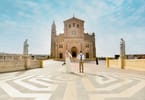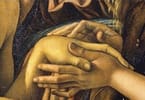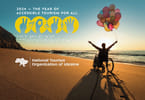(eTN) – Cairo’s blaze yesterday, March 24, swept through several residences, workshops and commercial areas in downtown al-Moski and al-Ghouriya areas near historic Cairo. It spared the Islamic monuments and sites in the city, confirmed Culture Minister H.E. Farouk Hosni. Sharia al-Moski, near the Khan el Khalili Bazaar, is a street market popular with tourists and locals alike.
Zahi Hawass, Secretary General of the Supreme Council of Antiquities (SCA), upon learning of the incident, assigned a committee led by Farag Fada, head of the Islamic and Coptic department, to inspect the Ottoman Mosque of Ali El-Metaher and the School of Al-Ashraf Bersbay, located close to the area of the fire. Cairo’s most famous ancient Al-Ashraf Barsbay mosque, built in 827 AD with intricate Islamic designs on its magnificent dome, was left unscathed.
Fada reported the Islamic monuments are in good condition, and the fire did not burn down any of the historic structures. Hawass added that members of the committee were close to the monuments until the Civil Defense Forces put out the blaze.
Al-Ghouria is one living example of the beauty of the architectural elements of Egyptian buildings in the Ottoman times. Here, every building demonstrates creativity on the designs of the facade which employed, with some accuracy, indigenous materials such as stones, mud bricks and wood. This district managed to revive architecture of the 20th century with artistry. Al-Ghouria encompasses a number of historical monuments belonging to different kingdoms and empires, old mosques, Sabils, religious schools/madarassa’s, age-old hotels and important monuments. People still live in this area that embraces long-standing commercial and manufacturing activities.
Al Moski was founded by Prince Ezz el Din Mosk, under Al Sultan Salah El Din El Ayoubi (Salahdin). This district starts from Al Attaba Square, runs parallel to Al Azhar Street up to the Al Azhar Mosque and El Hussein Mosque. Buildings here, characterized with a French-Belgian architectural feel, were built during the time of Ismail Pasha. The Pasha’s taste for European designs were carried over to the buildings of the Civil Defense and fire department, the post office building and the police station, as well as the Medical Affairs Directorate of Cairo governorate building, the National Theater or Egyptian Opera House (which burned in 1968) and the headquarters of the mixed court behind the Opera (removed after the Opera garage was built). With multiple entrances and lanes, the Al Moski, considered to be an important street market in Egypt, sells almost everything. Rows of streets are bursting with home goods, utensils and kitchenware. Home furnishings are pouring in El Saba Street while all types of fabric and cotton wear can be found in Al Samak. Musical instruments and chandeliers are sold in Darb el Barabra, El Mo’ez Le Din Allah Al Fatemy Street delight tourists with perfumery and an assortment of incense. Beans or ful, stuffed vegetables (eggplant or grape leaves) and the famous drink E’rk Sos, and bridal wear can be bought here too.
Al-Moski and Al-Ghouria stretch all the way to the main Fatimid street in Cairo, now the famous Khan el Khalili. The earliest buildings, built by Prince Jarkas el Khalili for Sultan Barqouq in the late 14th century, were of caravan-style, accommodating the merchants. Referred to, at times, as the tourist attraction more popular than the Pyramids in Giza, the Khan el Khalili area remains proud of its colorful heritage since 1342. It grew in importance in 1511 when Sultan Al Ghoury ordered the tearing down of the buildings for newer ones. In time, the vicinity grew through the Mamluk period, with courtyards surrounded by ground floor rooms for storing merchandise. Medieval stones and wood floorings, plenty of chaotic dungeon-like stairways characterize the complex.
Despite changing times, the souk marketplace has retained its charm and character on its own, but also made a name for tourists to bargain-shop. Bargaining is de rigueur in the famous arcade. From gold and silver jewelry, brass, copperware, inlaid work, leather items, glass-blown flacons to cooking pots, artifacts, camel chairs, onyx miniature pyramids, bed linen, comforters, coins, stamps, Egyptian furniture, antiques, china, white elephant displays, papyrus, everything sells for dirt-cheap prices if one can negotiate in Arabic (preferably). Through the years, the area has been known to cater largely to mass tourism markets bused around downtown. Pit-stops are recommended for tourists coming in droves. Khan el Khalili restaurant sits at the heart of the souk, which is hard to miss as the surrounding shops have neither the spit-polished exterior, nor the humble Naguib Mahfouz coffee shop cum water-pipe nook.
Besides the fire that did no damage, there’s one concern raising Cairene’s anxiety to a degree – the threat to the district’s ability to preserve the traditional atmosphere when millions of visitors apparently diminish the old charm. The state is pressed hard to restore its historical Islamic flavor. Locals worry, while Cairenes are not opposed to preserving the world’s biggest treasure trove of Islamic architecture, that refurbishment risks turning the souk into a flashy, modern theme park. Supporters and fanatics of the disorganized, disorderly Cairo buzz characterized by the hustle and bustle of Egypt’s busy capital don’t want any more structural change. People prefer the downtown as is, not turned into a straightened-up, cleaned-up tourist attraction. Cairo folks only wish for less traffic, minimized touting, less aggressive hawking or peddling and for more controlled pricing. Needless, this labyrinthine complex of bazaars had been put on the map of the Society for Preservation of the Architectural Resources of Egypt.
Everything else can otherwise be frozen in time, as far as the locals are concerned. They thank the fire did not destroy their Sultans’ legacy, their tourist lure.
WHAT TO TAKE AWAY FROM THIS ARTICLE:
- The Pasha's taste for European designs were carried over to the buildings of the Civil Defense and fire department, the post office building and the police station, as well as the Medical Affairs Directorate of Cairo governorate building, the National Theater or Egyptian Opera House (which burned in 1968) and the headquarters of the mixed court behind the Opera (removed after the Opera garage was built).
- Zahi Hawass, Secretary General of the Supreme Council of Antiquities (SCA), upon learning of the incident, assigned a committee led by Farag Fada, head of the Islamic and Coptic department, to inspect the Ottoman Mosque of Ali El-Metaher and the School of Al-Ashraf Bersbay, located close to the area of the fire.
- Musical instruments and chandeliers are sold in Darb el Barabra, El Mo’ez Le Din Allah Al Fatemy Street delight tourists with perfumery and an assortment of incense.






















